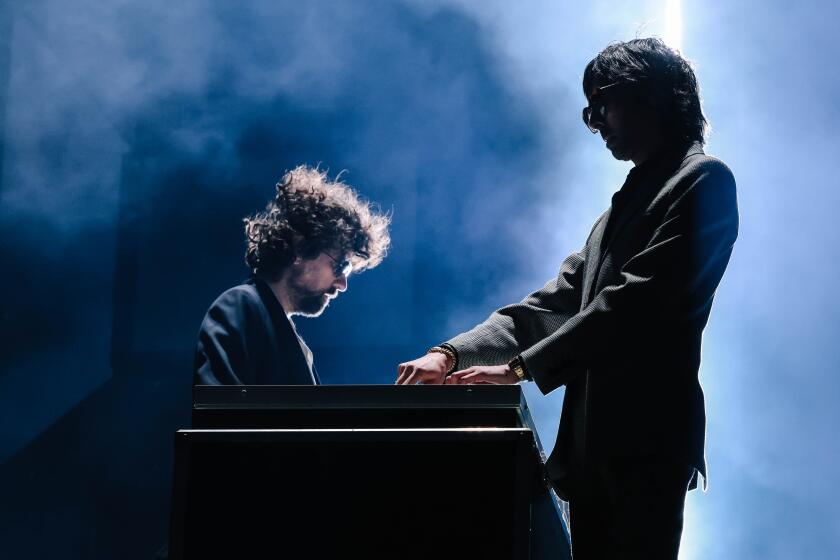MICROSCOPIC SEPTET’S MUSICAL MIX
Soprano saxophonist Phillip Johnston likes to think that the Microscopic Septet is building a bridge between rock and jazz.
Actually, it’s more like a spiral staircase between the two genres that the New York-based group--four saxophones plus rhythm section--has forged with its delightfully offbeat calypso-pop-Dixieland-noise-swing music.
“We are trying to take the essence of what jazz started out as, which was the same thing rock ‘n’ roll music is: It was fun and you could dance to it,” said Johnston, 30, in a telephone interview from Little Rock, Ark., where he was visiting friends.
“At the same time,” he continued, “the music can be technically proficient and have ideas. I don’t see that conflict in rock and I don’t see why there should be a conflict in jazz. We want our music to express the natural joy of playing that has gone out of a lot of jazz. People have this image of jazz as cult thing that’s serious and intellectual. But it started out as pop music.”
The group arrives in California this week for its first West Coast performances, Thursday at the Lingerie and Friday at Newport Harbor Art Museum. “A number of us lived there for years,” Johnston said, “so it’s going to be a sort of homecoming for us.”
Formed in 1983, the Microscopic Septet consists of musicians who have performed with acts as diverse as the Waitresses, Swollen Monkeys, the dBs, James White, the Raybeats and the ROVA Saxophone Quartet. Along with Johnston and pianist Joel Forrester, who write the group’s original material, the Microscopic Septet includes saxophonists Don Davis, Danny Nigro and Dave Sewelson, drummer Richard Dworkin and bassist David Hofstra.
After several years playing New York’s punk scene in various bands, however, the musicians decided that as they reached their 30s it was time to move on.
“Several of us were in a punk band called the Public Servants, which did to rock ‘n’ roll what the Microscopic Septet does to jazz. But one day we realized that while the other bands we were playing with were worried about pimples, the Public Servants were worried about losing their hair,” Johnston said with a chuckle.
Their backgrounds in legitimate jazz, experimental pop and the anything-goes world of punk results in songs ranging from “The Lobster Parade,” with its wacky Lawrence Welk-meets-the-B-52’s flavor, to “Johnny Come Lately,” a hard-swinging treatment of a Billy Strayhorn tune.
To help make ends meet, everybody in the group still works as a sideman in other bands. But, Johnston said, “We are definitely committed toward making this band happen. We’d like to get more national recognition, but it’s difficult because we’ve had two records on two different small labels.”
Despite a stockpile of enthusiastic reviews from the New York Times, Downbeat, Village Voice and Rolling Stone for their concerts and two albums--1983’s “Take the Z Train” and the new “Let’s Flip,” recorded live in the Netherlands--the band’s difficult-to-categorize music has been a stumbling block for some audiences and--especially--record companies, Johnston said.
“It’s like (Captain) Beefheart said, ‘Nobody’s found a label for this bottle yet.’ We bring together different elements that cause some people to turn their heads and say, ‘Wait a minute--those things aren’t supposed to go together.’ That can be a problem . . . but the average person doesn’t think about that. They are struck with the more immediate gestalt of rhythm, melody and nice chord changes. Our songs are very narrative and the act is also very visual. That’s why I think we have potential to go over in this country, where music is now about as separated as it can be.
“We’ve had some people who think you can’t be totally serious and totally humorous at the same time,” Johnston said. “That’s a difficult dichotomy to accept, but that’s the idea behind this band.”
More to Read
The biggest entertainment stories
Get our big stories about Hollywood, film, television, music, arts, culture and more right in your inbox as soon as they publish.
You may occasionally receive promotional content from the Los Angeles Times.






